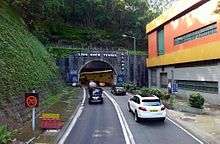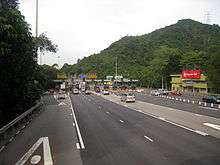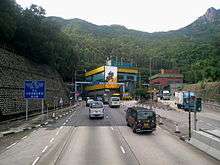Lion Rock Tunnel
 Entrance of the Lion Rock Tunnel in Sha Tin, Hong Kong | |||||||||||
| Overview | |||||||||||
|---|---|---|---|---|---|---|---|---|---|---|---|
| Location | Through Lion Rock, connecting Kowloon Tong to Tai Wai in Hong Kong | ||||||||||
| Coordinates | 22°21′21″N 114°10′22″E / 22.35583°N 114.17278°ECoordinates: 22°21′21″N 114°10′22″E / 22.35583°N 114.17278°E | ||||||||||
| Status | Active | ||||||||||
| Route |
| ||||||||||
| Start | Kowloon Tong | ||||||||||
| End | Tai Wai | ||||||||||
| Operation | |||||||||||
| Work begun | January 1962 | ||||||||||
| Opened |
14 November 1967 (Lion Rock Tunnel) 18 January 1978 (Second Lion Rock Tunnel) | ||||||||||
| Owner | Hong Kong Government | ||||||||||
| Operator | Greater Lucky (H.K.) Co., Ltd | ||||||||||
| Toll | HK$8 | ||||||||||
| Vehicles per day | 90,608 | ||||||||||
| Technical | |||||||||||
| Design engineer | Young Au Young | ||||||||||
| Length | 1.4 km | ||||||||||
| No. of lanes | 2 in each direction | ||||||||||
| Operating speed | 70 km/h | ||||||||||
| Chinese name | |||||||||||
| Traditional Chinese | 獅子山隧道 | ||||||||||
| Simplified Chinese | 狮子山隧道 | ||||||||||
| |||||||||||


The Lion Rock Tunnel, the first major road tunnel in Hong Kong, is a twin-bored toll tunnel, connecting Sha Tin in the New Territories and New Kowloon near Kowloon Tong. It has two lanes in each direction, with toll booths located at the Sha Tin end. It is a vital component of Route 1.
History
The construction of Lion Rock Tunnel started in January 1962.[1] The tunnel was opened on 14 November 1967, as a 1.43 km dual-one single bore tunnel. This tunnel is often described as a by-product of the Plover Cove Scheme, which was a project to build a water supply tunnel through the range of hills separating New Kowloon and the rest of the New Territories.[2] The Tunnel was designed by Young Au Young, a civil engineer from Shunde.
The government later saw the need for another road link between New Kowloon and Sha Tin when it decided to develop the latter as a new town. The Second Lion Rock Tunnel, which is 1.41 km long and situated to the west of, and lying parallel to, the old tunnel, was opened to traffic on 18 January 1978.
The new tunnel serves northbound traffic towards Sha Tin, while the old one serves southbound traffic towards Kowloon. Traffic in both directions share one of the tunnels when the other undergoes maintenance works.
Management
Since 1993, Serco has been contracted to manage, operate and maintain the tunnel, having successfully retained the contract in 1996 and 2000.[3]
The Tunnel has achieved both ISO 9001 and OHASA18001 in 2004. The toll to traverse the Lion Rock Tunnel is HK$8 each way.
On 23 April 2012, Greater Lucky (H.K.) Company Limited successfully bid the contract and took over the management with effect from 1 August 2012.
Renovation of the tunnel
As the facilities within the tubes of Lion Rock Tunnel are suffering from serious deterioration due to aging, as well as broken concrete on road surface which causes bumping when vehicles pass through, the Highways Department decided to undergo renovation works upon the tunnels in 2008. It will extend the lives of the tunnels for around 80 years more.
But the renovation may cause even more serious congestion of the tunnels and may change the starting time for one-tube-two-way traffic (using one tube only for both direction of traffic) from 12 am to 9 or 10 pm. The fire-resisting shields on the wall of the tunnels and the ceilings would be renovated, while the words “LION ROCK TUNNEL” and its Chinese counterparts would be retained on the sides of the entrances and exits of the tunnels.
Current usage
With the rapid development of the new towns, the tunnels have already reached its saturation flow just like Cross Harbour Tunnel. The flow was eased by other tunnels being put into service later, such as Shing Mun Tunnel, Tate’s Cairn Tunnel, Tsing Sha Highway. Nonetheless the convenience of its connection and directness, with a lower fee than the Tate’s Cairn Tunnel, Lion Rock Tunnel contributes to the highest daily average vehicles flow of all non-harbour-crossing tunnels. 90,608 vehicles used the tunnels everyday on average in 2014.[4]
See also
- Lion Rock
- Beacon Hill Tunnel, the first rail tunnel in Hong Kong, opened in 1910
- Transportation in Hong Kong
References
- ↑ "Lion Rock Tunnel: Breakthrough This Afternoon". South China Morning Post. Hong Kong. 20 November 1963. p. 6.
- ↑ Siu, Phila and Chan, Candy "More tunnel chaos ahead" Archived 25 November 2015 at the Wayback Machine. The Standard. 9 March 2012. Retrieved 2012-03-09
- ↑ "Transport–Lion Rock Tunnel" Archived 2 July 2012 at the Wayback Machine.
- ↑ "Traffic Statistics – Lion Rock Tunnel". Transport Department. Hong Kong. 2015.
External links
| Wikimedia Commons has media related to Lion Rock Tunnel. |
- Roads in the New Territories
- Transport department, toll rates
- Video: "Hong Kong. Tunnel Through Mountain" (1964)
| Preceded by Waterloo Road |
Hong Kong Route 1 Lion Rock Tunnel |
Succeeded by Lion Rock Tunnel Road |